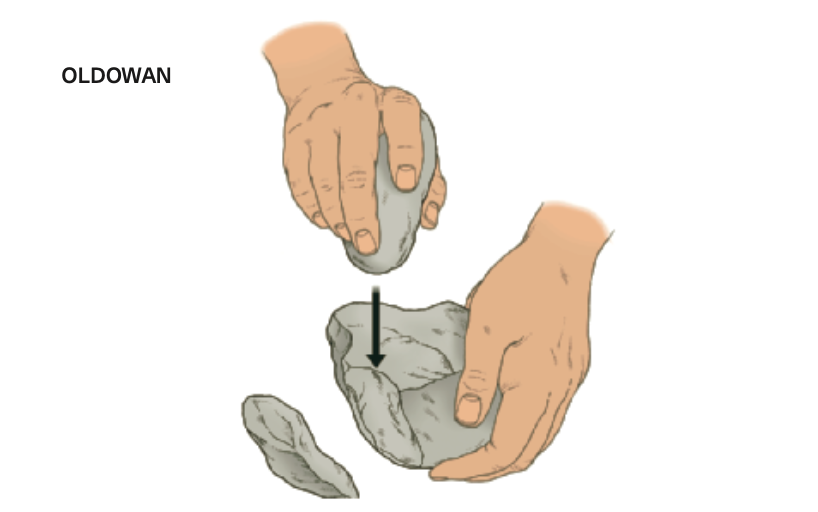Recent discoveries of stone flakes from Macaque monkeys are challenging previously made assumptions of human cognitive evolution and abilities (Greenfieldboyce 2023). The earliest stone tools were quite simple – using direct percussion, one would use a hammer stone to break off flakes of another stone, called the core, to create a tool. In the first stages of this development, tool-making often only meant breaking a stone in half to create a sharp edge, but this developed into more refined tools, created by carefully flaking off stone, eventually on both sides of the tool (Renfrew 2018, 212).

An important part of the daily life of the Macaque monkeys in Thailand is the consumption of oil palm nuts. To eat the nuts, Macaques place the nut on a flat stone and then hit it with another stone, cracking it open. When the monkeys miss the nut, which can happen often, they may unintentionally break the flat stone underneath the nut, creating stone flakes that are very similar to early stone tools (Zorich 2023).

Despite the fact that these flakes are largely understood to be unintentional and not used, there are a few possible implications of this discovery. The first is that early humans could have been inspired by the flakes they saw macaques making, leading them to create the first intentional stone flakes. Recent research has suggested that the date of development for stone tools may be over 3 million years ago rather than the previously imagined 2.6 million years ago. The discovery of these artifacts provides concrete evidence for an earlier date of the development of stone tools (Proffitt 2023).
The discovery of the Macaque stone flakes is also significant as it calls into the question the validity of flakes previously identified as anthropogenic. The stone flakes that the Macaques produce are almost indistinguishable from those intentionally created by humans. According to a study by Tomos Proffitt, around 20-30% of the earliest flakes could be attributed to the Macaques (2023). However, it is still possible to distinguish the two. Because the Macaque flakes were produced unintentionally and not used as tools, they lack the distinctive use-wear patterns that early human stone tools. In addition, if an archeologist has access to the core stone that the tools were flaked off of, they can analyze percussive patterns to determine if the entity creating the flakes had knowledge of fracture patterns and was using those patterns intentionally (Greenfieldboyce 2023).
Because both types of flakes are so similar, this discovery emphasizes the importance of an accurate behavioral interpretation of artifacts. Upon first glance, Macaque flakes can easily be confused with human’s intentional flakes. Only with careful observation and analysis can the two be identified as separate entities. However, the striking similarities between the two types of flakes provides important evidence for an earlier development date of stone tools used by humans, potentially altering our understanding of the evolution of human cognitive ability.
Resources:
Greenfieldboyce, Nell. “Stone Flakes Made by Modern Monkeys Trigger Big Questions about Early Humans.” NPR, March 10, 2023, sec. Shots – Health News. https://www.npr.org/sections/health-shots/2023/03/10/1161652099/monkey-stone-flakes-early-humans-tools.
“Monkeys Use Tools to Crack Nuts, Shuck Oysters .” CGTN, March 2018. https://news.cgtn.com/news/3451444f7a6b7a6333566d54/share_p.html.
Proffitt, Tomos, Jonathan S. Reeves, David R. Braun, Suchinda Malaivijitnond, and Lydia V. Luncz. “Wild Macaques Challenge the Origin of Intentional Tool Production.” Science Advances 9, no. 10 (March 10, 2023): eade8159. https://doi.org/10.1126/sciadv.ade8159.
Renfrew, Colin, and Paul Bahn. 2018. Archaeology Essentials: Theories, Methods, and Practice. Fourth edition. Thames & Hudson.
Zorich, Zach. “What Stone-Wielding Macaques Can Tell Us about Early Human Tool Use.” Scientific American, March 10, 2023. https://www.scientificamerican.com/article/what-stone-wielding-macaques-can-tell-us-about-early-human-tool-use/.
Further Reading:

How would this discovery help argue against anthropocentrism, and why is it valuable for us to acknowledge the cognitive capacities of non-human/pre-historic humans? Why might the anthropocentric discourse be limiting to the anthropology discipline?